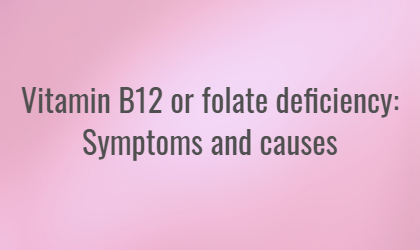
There are various types of anaemia, and each one has its own unique and complex cause. The most widely experienced anaemia is iron-deficiency anaemia, with around 500 million cases reported worldwide (1). (Link to article: Vitamin B12 or folate deficiency anaemia: signs and symptoms)
And yet, though many different factors contribute to the development of anaemia, its presentation is always the same: the body has fewer red blood cells or less haemoglobin than usual, which comprises its function.
With symptoms like fatigue and heart palpations, iron deficiency anaemia is often mistaken for stress and tends to go unnoticed. But the sooner you recognise the red flags, the more likely you are to treat the problem and restore yourself to full health.
If you suspect you might be suffering from anaemia, you’re in the right place. Here, we outline the key symptoms and causes.
The importance of red blood cells and haemoglobin
Red blood cells and haemoglobin are critically important components of blood since they transport oxygen from your lungs to all corners of the body.
Red blood cells are made in the bone marrow and live for around 120 days, after which point the liver and spleen remove them.
Haemoglobin, meanwhile, is a substance found in red blood cells that bind to oxygen and give blood its rich red colour. Haemoglobin makes up roughly a third of a red blood cell.
Anaemia symptoms
If you have lower-than-normal levels of either red blood cells or haemoglobin, your body won’t get the oxygen it needs to work effectively. As a result, you may experience some of the anaemia symptoms below.
(Anemia) Anaemia skin
A lack of haemoglobin in the red blood cells – which gives blood its red colour – and a shortage of overall red blood cells mean fewer red blood cells reach the skin’s surface, making it appear pale in colour (2).
Paleness isn’t contained to one area of the body; the gums, nails, the inside of the lips and eyelids, and nails may also lose their colour and warmth.
It’s worth noting that paleness tends to be more prevalent in moderate to severe cases of anaemia (3).
Anaemia eyes
Like pale skin, pale eyelids can also be indicative of anaemia. In a healthy individual, the inner lower eyelid should be a vibrant red colour. If, however, it’s pale or yellow, it may reveal iron-deficiency anaemia.
Fatigue
Experiencing crashing and unrelenting tiredness is often a warning sign that you might be falling short in iron and experiencing anaemia (4).
If you have anaemia, you don’t have enough haemoglobin in your red blood cells. And since oxygen binds to haemoglobin, this means your red blood cells can’t carry as much oxygen throughout the body to your muscles and organs, which can lead to fatigue.
Weakness, irritability, and brain fog often accompany anaemia-related tiredness.
Breathlessness
As we’ve already established, haemoglobin helps your red blood cells transport oxygen around the body. And if your haemoglobin levels are low, your oxygen levels will also fall short.
On a day-to-day basis, this means your muscles won’t receive as much oxygen to carry out simple activities, like walking, and may lead to shortness of breath (5).
Heart palpitations
Being hyperaware of your heart beating in your chest – otherwise known as heart palpitations – can be another symptom of anaemia. If you have iron-deficiency anaemia, the heart must work even harder to transport oxygen around the body.
As a result, you may experience irregular heartbeats or feel your heart beating much faster than usual (6).
Other warning signs of iron-deficiency anaemia
-
Dizziness
-
Headaches
-
A tingling or crawling feeling in your legs
-
Experiencing strange cravings to eat non-food items – otherwise known as ‘pica’ – including ice, clay, or dirt
-
Cold hands and feet
-
Brittle nails
-
Hair loss
What causes iron-deficiency anaemia?
The causes of iron-deficiency anaemia are complex and multifactorial.
In adult men and postmenopausal women, the most common cause of iron-deficiency anaemia is blood loss from the gastrointestinal tract. This can result from a stomach ulcer, inflammation of the bowel or the food pipe, or certain medications, particularly non-steroidal anti-inflammatory drugs, such as ibuprofen (7).
According to the British Society of Gastroenterology, two to five per cent of adult men and postmenopausal women in the developed world have iron-deficiency anaemia (8)
The most common cause of iron-deficiency anaemia amongst premenopausal women is heavy menstruation due to the loss of iron-containing blood each month. (Link to article: Women and anaemia)
An insufficient intake of dietary iron may also be responsible for iron-deficiency anaemia. Since animal foods – especially red meat – are some of the best sources of highly absorbable ‘haem’ iron, vegans and vegetarians may be at risk. Individuals on restricted diets may be susceptible to iron-deficiency anaemia, too.
It’s also worth mentioning that consuming large amounts of tea, coffee, milk, and dairy can make it harder for your body to absorb iron (9).
What can happen if iron-deficiency anaemia is left untreated?
Although it may seldom be severe or cause long-term complications, having mild, untreated iron-deficiency anaemia can lower your immune system and make you more prone to infections.
On the other hand, severe anaemia may affect your heart and lungs and lead to an abnormally fast heartbeat (tachycardia) or even heart failure.
Treating iron deficiency anaemia
Thankfully, treating iron-deficiency anaemia is relatively simple. Your GP may prescribe a course of iron tablets and ask you to make some changes to your diet.
Iron-deficiency anaemia can make you feel thoroughly wrung out and exhausted. For that reason, its symptoms are often conflated with stress and burnout. But if you spot the signs early, you can easily take the necessary steps to treat iron-deficiency anaemia.
If, after reading this, you suspect that you may have iron-deficiency anaemia, have a chat with your GP and arrange for a blood ferritin test to determine an exact diagnosis.
References
-
Cks.nice.org.uk. 2021. Anaemia - iron deficiency. Health topics A to Z CKS NICE. [ONLINE] Available at: https://cks.nice.org.uk/anaemia-iron-deficiency
-
Nhlbi.nih.gov. 2021. Iron-Deficiency Anemia NHLBI, NIH. [ONLINE] Available at: https://www.nhlbi.nih.gov/health-topics/iron-deficiency-anemia
-
Regina, D., C., S. and Rao, R., (2016). Correlation of pallor with hemoglobin levels and clinical profile of anemia in primary and middle school children of rural Telangana. International Journal of Contemporary Pediatrics, 872-877.
-
Bager P. (2014) Fatigue and acute/chronic anaemia. Dan Med J. 61(4):B4824. PMID: 24814598.
-
Abbaspour, N., Hurrell, R., & Kelishadi, R. (2014). Review on iron and its importance for human health. Journal of research in medical sciences; the official journal of Isfahan University of Medical Sciences, 19(2), 164–174.
-
Lopez A, Cacoub P, Macdougall IC, Peyrin-Biroulet L. (2016) Iron deficiency anaemia. Lancet; 387(10021): 907-16.
-
nhs.uk. 2021. Iron deficiency anaemia. [ONLINE] Available at: https://www.nhs.uk/conditions/iron-deficiency-anaemia/
-
The British Society of Gastroenterology. 2021. Guidelines for the management of iron deficiency anaemia The British Society of Gastroenterology. [ONLINE] Available at: https://www.bsg.org.uk/clinical-resource/guidelines-for-the-management-of-iron-deficiency-anaemia/
-
nhs.uk. 2021. Iron deficiency anaemia. [ONLINE] Available at: https://www.nhs.uk/conditions/iron-deficiency-anaemia/
Related Posts
Disclaimer: The information presented by Nature's Best is for informational purposes only. It is based on scientific studies (human, animal, or in vitro), clinical experience, or traditional usage as cited in each article. The results reported may not necessarily occur in all individuals. Self-treatment is not recommended for life-threatening conditions that require medical treatment under a doctor's care. For many of the conditions discussed, treatment with prescription or over the counter medication is also available. Consult your doctor, practitioner, and/or pharmacist for any health problem and before using any supplements or before making any changes in prescribed medications.

Keri
Keri Filtness has worked in the Nutrition Industry for 19 years. She is regularly called upon for her professional comments on health and nutrition related news. Her opinions have been featured by BBC3, Prima, Vitality, The Mirror, Woman’s Own and Cycling Weekly, amongst others. She has also worked one to one with journalists, analysing their diets and health concerns and recommending changes and additions, where appropriate.



